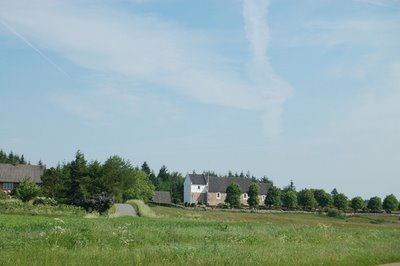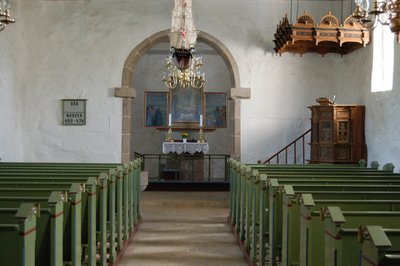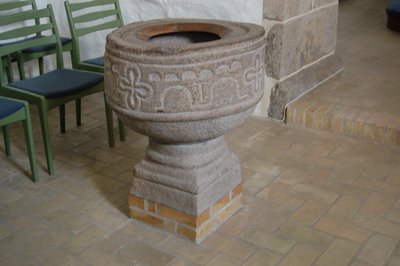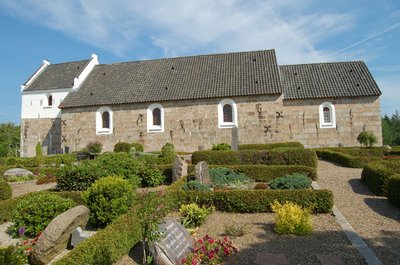
Hjortdal church, Thy, 8 km northeast of Fjerritslev

Interior

Romanesque granite font


The desolate placed Hjortdal church from the 1100s has a Romanesque choir and nave, a low late Gothic tower to the west and a porch from 1586 to the north. The Romanesque part is built in granite ashlars. The north door is still in use ,while the south door shows vague traces in the outer wall. In the eastern wall of the choir is a round arched monolit cover stone in its original place, while the window itself is walled-in. In the nave are no original windows.
The inside of the church has beamed ceilings and the original choir arch is preserved. The late Gothic tower is built in re-used ashlars and raw boulder. Its small tower arch is almost circular and the room has traces of a disappeared of not finished vault. The upper sections of the tower was demolished in ab. 1807 and it is now only a little higher than the nave.
The Romanesque communion table is in granite ashlars. The altar piece has sections from a piece from 1700, but with new wings and a painting from 1942. An earlier altar painting from 1856 was painted an given by fru Lucie Ingemann. A Romanesque granite font with Romanesque granite font has cruciflowers and arch friezes upon the basin. A south German baptismal basin from ab. 1575, given in 1695 by Sidsel Mickelsdatter. A pulpit from 1592, a Aalborg-joinery with flatcarved fields, a gift from Palle Griis, the owner of Slettegård. The sounding board above the pulpit it is from 1598, made by another cabinet-maker, restored in 1959. A pengeblok (iron bound oak post) from 1777. A door wing from 16-1700s is now in the north door of the tower. A church bell from ab. 1450-75 by PLP.
Gravestones: 1) Romanesque granite, no inscriptions, with cross and other figures, probably a gable stone; 2) parish priest Rasmus Lind, + 1757 ; 3) Chr. Brix, + 1807; 4) Mette Cathrine Mørup, + 1838; 5) Søren Mørup, + 1849.
Names in the Middle Ages and 1600s:
Hjortdal (* 1386 Vester Hiertells, 1458 Hiortils, 1470 Hiortels)
Vester Svenstrup (1466 Wester Swenstrvp); Sanden (1688 Paa Sand); Slettegård (1450 Slætæ); Nørtorup (1466 Torop gord, 1688 Nør Torup) ; Fasmali (1638 Faszmerlie, 1664 Fosmelie); Hedegård (1638 Hædegaardt).
Slettegård, was earlier named Slette, belonged for a long period to the lavadelsslægten (lesser nibility) Griis. The earliest known owner was Anders Griis in Slette in 1450-70, his son Palle Griis is mentioned in 1494 , he must have been deceased in ab. 1530, for two years later was written: " Here lived some years ago a peasant in Hanherred, named Palle Griis...". His four sons: Anders, Christoffer, Bagge (+ 1534 in an attempt to kill Skipper Clement) and Niels Griis owned Slette together. Niels Griis died before 1556 , since his widow Bodil Svendsdatter Orning was the owner of S. at that time. The son Palle Griis (+ 1618) inherited S. and it went on to his son Bagge Griis, who was the owner in 1608 and 1633. He died one or two years later. His sister Anne Griis brought in 1630 a part of S. to her husband Vogn Krag (Kid) who still lived there in 1651. Still in the 1700s Slette/Slettegård belonged to the family Griis and their descendants. Slettegård was very reduced in 1943 where it was sold to P. Kornum.
In Vester Svenstrup was a main farm Nørgård (*1480 Nørregardh) or Svenstrup, which in 1519 belonged to Christen Krag (of the family Kid), in 1538-45 to his son Mikkel Kid or Krag (+ before 1557) whose heirs owned it in 1568. Mikkel K.'s son's son (?) Vogn Krag was the owner of S. in 1623-34, and his brother Poul Krag (+1641) sold in 1632 his part of Nørgård in Vester Svenstrup to Christoffer Kaas (+ ab. 1656) ( of the family with a sparre (chevron) in their coat of arms.
Another main farm, Nørgård in Torup, later named Nørtorup, must have belonged to Palle Griis of Slette (+ ab. 1530) and after him to his three sons: Bagge, Anders and Niels Griis. Bagge Griis' daughter Karen was married to Munk Elbæk (of the family Vognsen of Stenshede) whose heirs in 1568 owned 1/3 of N, and their son Palle Munk is mentioned in 1580 as heir of N. Anders Griis' son Vogn Griis owned in 1568 (together with his siblings) 2/3 of N., and his sons Anders and Jakob Griis (+ 1651) lived her. From 1699 various owners.
In Vester Svenstrup is mentioned the farm Præstbjerg (1552 Prestbierig) in the 1500s and 1600s. At Nørtorup was a farm Hellegård, mentioned in 1688. The houses , 1664 Wildboren and 1688 Fischer Huuset were built in the area by Slette. The mill Slettemølle was probably named Søndermølle in the Middle Ages.
Listed prehistorics: A long hill south of Hedegård and 51 hills, of which several are large: Torshøj west of the church, Duehøj at Nørtorup, Gravenhøj in Fosdal plantation and two hills, i.e. Knaghøj in Svinkløv plantation. A bautasten (menhir) Den grå sten ( the Grey Stone), which once belonged to a row of stones by a hill in a group of 6 hills south west of Vester Svenstrup. Demolished or destroyed: 57 hills, which mainly were on the hillsides to the south and the east.
Sct. Olufs Kilde ( sacred spring) at the foot of a tall hill at Svinkløv was used as a healing spring until ab. 1890.
In a letter of 1555 it was decided that Hjortdal church had to be demolished, the parish people from Hjortdal and Hedegård then had to go to other churches, but in 1558 the decision was given up because of the intercession from the parish.
The parish of Hjortdal was almost annihilated by a violent sand drift which ravaged the area from the 1600s up to the 1800s. The area around the church yard is still marked by the sand drift from then.
The church is situated in the outskirts of Svinkløv plantation together with the manor Slettegård in a beautiful cultural environment. An old gravel road leads from the church to Slette Å and then upon an old characteristic ashlar bridge across Slette Å down to the manor.
Hjortdal was situated on one of the Middle Age's road connections from the Thing and bishopric in Viborg to the powerful Børglum Kloster. From the crossing by Aggersborg people rode via Hjortdal and Lerup church, where a Holy spring once was - and through the beautiful Fosdalen down to the coast, where the beach made a safe passage to the north.
Source: Trap Danmark, Thisted amt.


Svinkløv Badehotel and the beach in June.
photo 13 June 2006: grethe bachmann
No comments:
Post a Comment